How to clear a clog in the bathroom: a review of the best methods for clearing drains
Blockage is a problem that sooner or later all owners of both apartment buildings and country cottages face.But to solve a sudden misfortune, it is not always possible to attract a professional technician.
Let’s take a closer look at how to remove a blockage in the bathroom on your own and what measures to take in the future to prevent the problem.
The content of the article:
Finding out the cause of blockages
Any blockage is formed as a result of violation of the established rules for sewerage operation. In multi-storey buildings, the blockage can be local - within one apartment, or general, when the common sewer line is clogged.
The cause of a clogged pipe in the bathroom may be:
- settling on the walls of mud lumps formed from particles of small debris and hair;
- layering of fatty deposits on the pipes;
- insufficiently maintained pipe slope during installation;
- deterioration of the sewer system as a whole.
Household members cannot always keep track of what settles on the drain grate. Animal hair, fabric fibers and long hair, along with waste water, flow into the drain hole and get stuck in it.
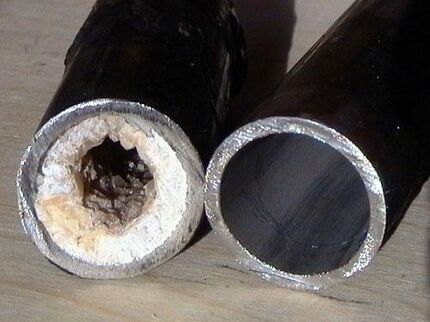
Choosing the optimal way to eliminate local sewer blockage within the apartment depends on the size of the mud “plug”.The general blockage will most likely have to be eliminated using professional equipment.
Mechanical methods of elimination
The fight against clogging of the pipe passage should begin as soon as even a slight stagnation of water is detected. You can solve the problem by using one of the methods described below. To achieve maximum effect, you should try using two approaches at once, performing mechanical and then chemical cleaning.
Often, to combat a blockage, it is enough to perform simple manipulations, as in the example of removing a plug from a siphon with a semi-automatic overflow:
If the situation is more serious than described, then you need to use more drastic cleaning means.
Using a rubber plunger
The simplest and most gentle way to clear small blockages is to use a plunger. The tool can be equipped with an elastic flat washer or cone-shaped nozzle.The shape of the rubber bowl of the tool is selected depending on the required degree of compression effect on the unit being cleaned.
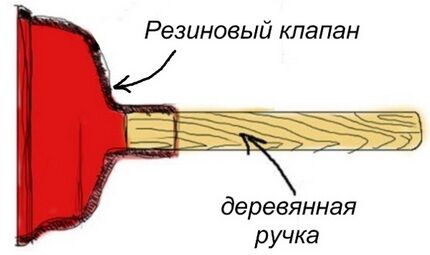
When choosing this method of eliminating the problem, it is worth considering that using a plunger to break through a dirt plug through the drain hole of a bathroom bowl is much more difficult than through a sink drain.
This is explained by the design of the bathroom drain, complemented by an overflow hole. When a blockage forms and water overflows, air accumulates inside the opening, while a vacuum is required to operate the plunger.

Before using a plunger to break through the clog in the bathroom, you need to tightly close the overflow hole. This can be done using a rubber stopper or a piece of fabric folded in several layers.
Some craftsmen use another plunger to block the hole. But in this case, the work should be done by two people: one covers the overflow, the other cleans the drain.

Work to remove the blockage is carried out in several stages:
- Press the plunger bowl tightly so that it completely covers the drain hole.
- Make 10-12 sharp back-and-forth movements without lifting the nozzle from the surface so that the air moves sharply towards the drain hole and the blockage is crushed.
- With a sharp movement, remove the tool from the drain. Open the water and rinse the pipe with crushed dirt.
If the efforts made do not bring the desired effect, it is worth trying to push the mud seal through not with air, but with water. For this purpose, 10-15 liters of hot water are poured into the bath so that it covers the rubber bowl of the tool by 2/3. The plunger is immersed in water at an angle and several reciprocating movements are performed.
With the last “pump”, the instrument is sharply removed from the water and observed whether it begins to sink into the drain. If necessary, the procedure is repeated 3-4 times.
The sewer outlet is cleaned using the following technology:
Application of plumbing cable
To remove more global blockages, use plumbing cable, made of galvanized steel metal. The only thing is that it should be used with great caution for cleaning chrome and polymer pipes, the inner surface of which can be damaged when exposed to the sharp ends of a brush.
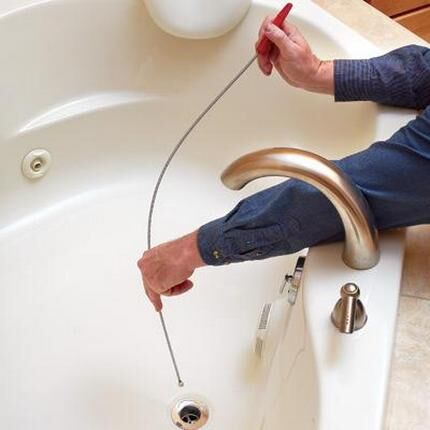
For work, you can use factory tools of both rope and spring-wound versions. The master’s task is to use a brush or hook located at the end of the tool to hook the blocking object and pull it out, or, on the contrary, push it into a wider part of the highway.
In the absence of the opportunity to purchase a tool, you can make it yourself. To do this, take a two-three meter piece of flexible metal cable, and lightly “fluff” its end, forming an improvised brush.
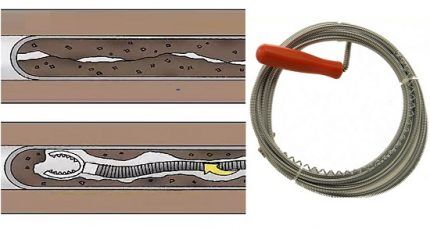
Before clearing a dense clog in the bathroom, you must carefully inspect the tool for mechanical damage. It is advisable to lubricate the bushings located near the cable handle.
Cleaning using a cable is performed in the following sequence:
- The tip of the cable is buried in the drain hole, holding the handle of the tool in your hand.
- Push the cable, producing rotational movements.
- When you reach the clogged area, perform a couple of sharp jerks back and forth, increasing the pressure.
- Carefully remove the cable, picking up the debris with the nozzle.
- Open the tap and run hot water in order to rinse the pipe with the crushed plug.
When cleaning the dirt plug, the plumbing cable must be kept taut. Rotation of the tool during the pushing process contributes to the fastest destruction of the plug.
Cleaning the siphon device
Stagnation of water, accompanied by the appearance of a characteristic unpleasant odor, may indicate that a plug has formed in the walls of the siphon. This structural element performs two tasks at once: it prevents the penetration of sewer odors and protects the system from the ingress of foreign objects.
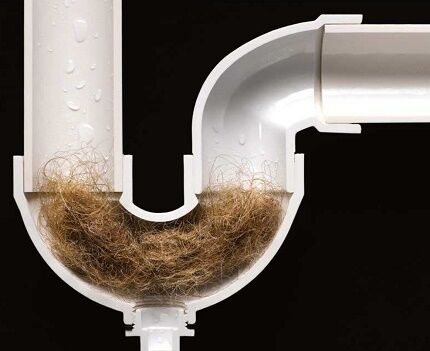
Before disassembling the siphon, directly under its location it is necessary to spread a piece of old cotton fabric that absorbs moisture well.
Cleaning the siphon is performed in the following sequence:
- A container with low sides is installed under the location of the siphon, into which liquid from the disassembled structure will drain.
- Unscrew the shutter nut and disconnect the flask from the outgoing pipe.
- The water that served the function is drained from the flask water seal.
- The bottom of the siphon is unscrewed and cleared of accumulated deposits by wiping the surface from the inside with a sponge and washing it with a stream of water.
- The flask is installed in its original place, docking with the outgoing pipe.
- Open the tap so that water fills the water seal and check the integrity of the connections.
When assembling the structure and installing the flask in its original place, it is important to place it in such a way that the drain pipe does not rest on it. If you do not adhere to this requirement, the water seal will be broken when starting the system. As a result, there will be a persistent sewer smell, which is quite difficult to get rid of in a short time.
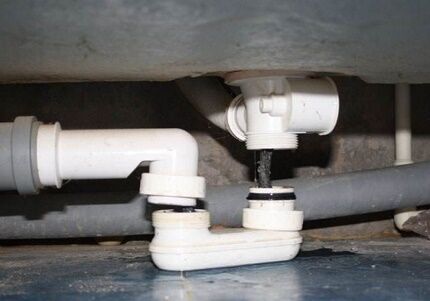
Lumps of garbage removed from the siphon should not be flushed down the drain so as not to clog the system. They are best disposed of as household waste.
Faithful helpers - chemicals
The modern market offers many ready-made preparations that allow you to decide how to effectively remove blockages in the bathroom. The active ingredients of the compositions are able to soften and destroy plugs of organic deposits.
They are available in the form:
- liquid concentrates;
- semi-liquid gels and foams;
- dry powders.
The main thing when working with chemicals is to maintain the concentration and waiting time specified by the manufacturer. Even the safest ones cleaning compounds are able to have a beneficial effect only within a certain time period.
With prolonged contact, they can even cause deformation of the material from which the pipes are made.
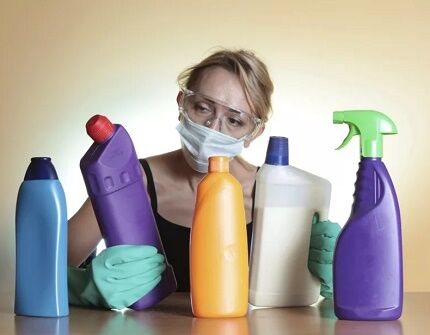
Apply ready-made drugs pretty easy. They are simply poured into the drain hole and wait for the time specified by the manufacturer.Then open the tap and rinse the pipes generously with a stream of water.
If a powdered composition is chosen for cleaning, after pouring it into the drain cavity, fill it with a small portion of water and wait for the time specified by the manufacturer. Next, as when working with liquid compounds, rinse the system with a generous portion of warm water.
The most popular drugs for sewer flushing from leading manufacturers that have proven themselves in removing blockages:
- “Mole” is a liquid concentrate based on sodium hydroxide and modified acetic acid that easily removes fatty deposits. Due to the aggressiveness of the components of the composition, it cannot be used for processing plastic pipes.
- “Tiret” is a gel-like composition that quickly and effectively removes any kind of blockage. It fits both metal and plastic pipelines.
- “Floop” - a granular preparation that easily removes limescale, collagen fibers and fatty deposits.
- "Mr. Muscle" is a universal gel-like product suitable for all types of pipes. In addition to its main function (destroying dirt plugs), the drug kills bacteria, thereby helping to get rid of the unpleasant odor from the drain.
- "Bagi Pothan" - a product based on caustic soda effectively removes even the most severe blockages, which include food debris, hair and lime deposits. Its only drawback is the strong chemical smell.
Under the Tiret brand, a line of products is produced designed to dissolve organic accumulations in pipes of different composition and condition:
Most of the described preparations are based on acids and alkalis, for example, caustic soda. Therefore, when working with them, it is important to observe safety precautions.
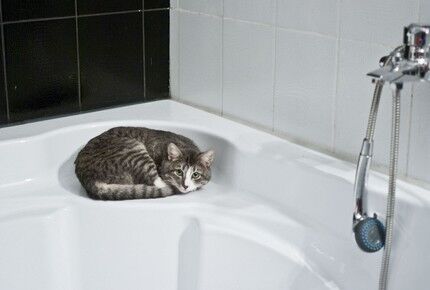
In order to protect the mucous membranes and skin from chemical burns, when working with reagents, you should be properly equipped, wearing safety glasses, an oilcloth apron and rubber gloves.
An effective folk method
A time-tested folk remedy will also help eliminate the problem. A solution of soda ash and vinegar gives a good effect. When baking soda reacts with acid, it produces large amounts of carbon dioxide. In a closed space, it pushes through the congestion.
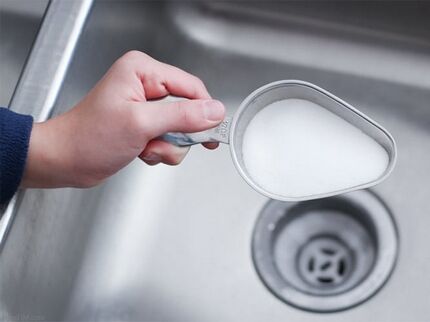
Instead of vinegar, you can use citric acid or freshly squeezed juice of one lemon. In any case, the prepared product will not “hit your wallet” much.
Sequence of actions:
- Pour ½ pack of baking soda into the drain hole.
- After 10-15 minutes, when the powder is compacted, half a glass of vinegar is poured into the hole.
- When the chemical reaction begins, the hole is covered with a stopper.
- 60-90 minutes after the “seething” is completed, the tap is opened and 5-6 liters of hot water are poured into the hole.
The method using soda and vinegar is only effective for clearing blockages located close to the drain. The further away the plug is, the lower the pressure of the released gas.
How to prevent problems in the future?
Regular preventive maintenance will help you avoid trouble in the future. To protect the pipeline system from the accumulation of dirt lumps, the drain hole must be equipped with a simple device - a protective grill.
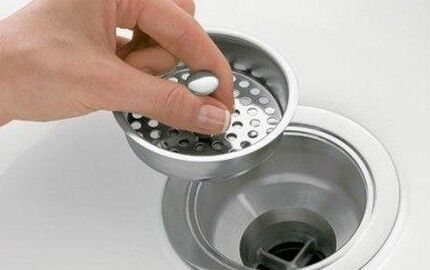
It is also worth pouring small portions of hot water into the drain every week. It will melt fat deposits, facilitating their further movement along the highway.
The use of chemicals has a good preventive effect. To achieve the desired result, they should be used at least once every six months. But to minimize the risk of pipe damage, they should be used in accordance with the instructions.

To minimize the risk of dirt seals forming, it is recommended to periodically disassemble and wash the siphon elements.
Conclusions and useful video on the topic
Video #1. We remove the blockage using improvised means:
Video #2. Cleaning pipes with a plunger:
Video #3. Cleaning pipes using a cable:
Proper operation of plumbing equipment in combination with regularly carried out preventive measures will prevent the occurrence of “traffic jams” and will extend the service life of the system.
How did you clear a clog in your bathroom drain pipes? Perhaps you have tools and methods in your arsenal that are much more effective than the methods we have proposed. Please write comments in the block below, post photos related to the topic of the article, and ask questions about points of interest.




Folk remedies, as I was convinced, are ineffective, so I stopped using them. If the clog is small, then I use a plunger. Of the chemical products, I like “Chistin” the most, but “Mr. Muscle” did not justify itself. Dear, but there is little benefit. Although it has a pleasant smell, it completely overpowers other aromas. If they don’t help, you have to call your husband. It always solves this problem in my pipes.
Usually, we use products like “Mole” to deal with blockages, but if chemical options don’t help, then my husband takes up cleaning the drain using mechanical methods.Unscrews the drain as far as possible, gets to the pipe and cleans it with a special thin cable. The main thing is to be careful not to punch an extra hole anywhere; now everyone’s pipes are mostly plastic. In this case, plungers are absolutely useless. We can cope on our own.
I agree that there is no better way to clean a pipe than a plumbing cable. It is not necessary to disassemble the pipe for this, only if the blockage is very severe.
Drain under the bathtub. Doesn't understand. Metal pipes. Chemistry did not help. The 10 mm cable does not go through the “knee”. 5 mm cable - not enough rigidity. Yes, the pipe behind the “elbow” was completely clogged (probably limescaled). I bought another 7mm cable. I cut about 70 cm and inserted it into the bathtub through a tube about 30 cm long. I twisted the cable with a drill (I know it’s dangerous). I was able to drill a hole in the blockage. Then he removed the tube and continued the procedure without it. Well, then, just for fun, I stuck the rest of the long cable into the pipe (without the help of a drill). So the drain began to work, and better than before.